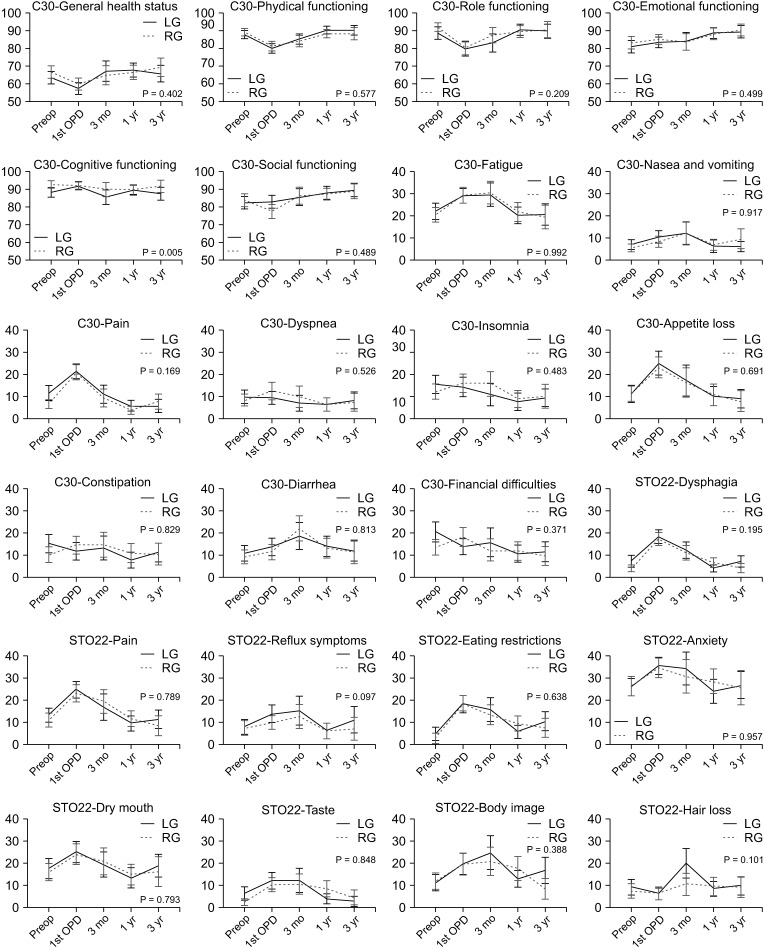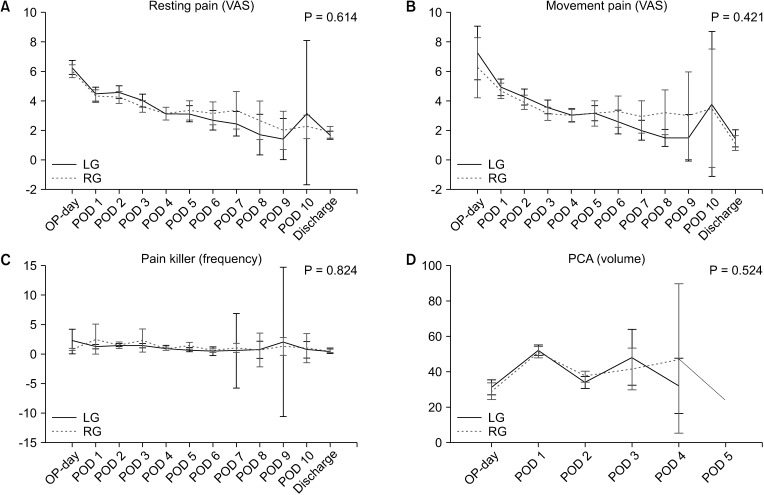Ann Surg Treat Res.
2020 Nov;99(5):275-284. 10.4174/astr.2020.99.5.275.
The pattern of postoperative quality of life following minimally invasive gastrectomy for gastric cancer: a prospective cohort from Korean multicenter robotic gastrectomy trial
- Affiliations
-
- 1Department of Surgery, Seoul National University College of Medicine, Seoul, Korea
- 2Department of Surgery, Ajou University College of Medicine, Suwon, Korea
- 3Cancer Research Institute, Seoul National University College of Medicine, Seoul, Korea
- 4Center for Gastric Cancer, National Cancer Center, Goyang, Korea
- 5Department of Surgery, Chung-Ang University College of Medicine, Seoul, Korea
- 6Department of Surgery, Yonsei University College of Medicine, Seoul, Korea
- 7Department of Surgery, Dong-A University College of Medicine, Busan, Korea
- 8Department of Surgery, Korea University College of Medicine, Seoul, Korea
- 9Department of Surgery, College of Medicine, The Catholic University of Korea, Seoul, Korea
- 10Department of Surgery, Inje University College of Medicine, Busan, Korea
- 11Department of Surgery, Hallym University College of Medicine, Seoul, Korea
- 12Department of Surgery, Hanyang University College of Medicine, Seoul, Korea
- KMID: 2508324
- DOI: http://doi.org/10.4174/astr.2020.99.5.275
Abstract
- Purpose
Quality of life (QOL) has become important in the trend of emphasizing patient satisfaction. This study aimed to evaluate the QOL in patients who underwent laparoscopic or robotic gastrectomy for gastric cancer.
Methods
A prospective trial was performed involving patients who underwent laparoscopic or robotic gastrectomy for primary gastric cancer at 11 hospitals in Korea. Within this comparative trial, QOL, postoperative pain, and long-term complications were exanimated. The quality-of-life questionnaire (QLQ)-C30 and QLQ-STO22 developed by the European Organization for Research and Treatment of Cancer were used for the QOL survey. We compared the data after dividing it into several types of characteristics as follows; device (robotic or laparoscopic), operation type, pathological stage, and sex. Biased components were extracted by logistic regression analysis. Propensity score matching was applied to the data set with the biased components.
Results
In total, 434 patients (211 for laparoscopic surgery and 223 for robotic surgery) were enrolled, out of which 321 patients who responded to both preoperative and postoperative surveys were selected for analysis. Robotic gastrectomy was not different from laparoscopic gastrectomy with respect to postoperative QOL. Distal gastrectomy showed better scores than total gastrectomy in terms of role functioning, social functioning, fatigue, nausea/vomiting, pain, dyspnea, constipation, financial difficulties, dysphagia, eating restrictions, anxiety, taste, and body image. Male patients showed better scores on the 19 scales compared to female patients.
Conclusion
Robotic and laparoscopic approaches for gastric cancer surgery did not differ from each other with respect to QOL. Distal gastrectomy resulted in better QOL than total gastrectomy.
Keyword
Figure
Cited by 1 articles
-
Postoperative quality of life after gastrectomy in gastric cancer patients: a prospective longitudinal observation study
Chao-Jie Wang, Yun-Suhk Suh, Hyuk-Joon Lee, Ji-Hyeon Park, Shin-Hoo Park, Jong-Ho Choi, Fadhel Alzahrani, Khalid Alzahrani, Seong-Ho Kong, Do-Joong Park, Hui Cao, Han-Kwang Yang
Ann Surg Treat Res. 2022;103(1):19-31. doi: 10.4174/astr.2022.103.1.19.
Reference
-
1. Lee HJ, Yang HK. Laparoscopic gastrectomy for gastric cancer. Dig Surg. 2013; 30:132–141. PMID: 23867590.2. Kitano S, Shiraishi N, Uyama I, Sugihara K, Tanigawa N. Japanese Laparoscopic Surgery Study Group. A multicenter study on oncologic outcome of laparoscopic gastrectomy for early cancer in Japan. Ann Surg. 2007; 245:68–72. PMID: 17197967.3. Kim HH, Han SU, Kim MC, Kim W, Lee HJ, Ryu SW, et al. Effect of laparoscopic distal gastrectomy vs open distal gastrectomy on long-term survival among patients with stage I gastric cancer: the KLASS-01 randomized clinical trial. JAMA Oncol. 2019; 5:506–513. PMID: 30730546.4. Oh SY, Lee HJ, Yang HK. Pylorus-preserving gastrectomy for gastric cancer. J Gastric Cancer. 2016; 16:63–71. PMID: 27433390.5. Jung DH, Ahn SH, Park DJ, Kim HH. Proximal gastrectomy for gastric cancer. J Gastric Cancer. 2015; 15:77–86. PMID: 26161281.6. Choi JH, Suh YS, Park SH, Kong SH, Lee HJ, Kim WH, et al. Risk factors of microscopic invasion in early gastric cancer. J Gastric Cancer. 2017; 17:331–341. PMID: 29302373.7. Kobayashi D, Kodera Y, Fujiwara M, Koike M, Nakayama G, Nakao A. Assessment of quality of life after gastrectomy using EORTC QLQ-C30 and STO22. World J Surg. 2011; 35:357–364. PMID: 21104250.8. Yun YH, Park YS, Lee ES, Bang SM, Heo DS, Park SY, et al. Validation of the Korean version of the EORTC QLQ-C30. Qual Life Res. 2004; 13:863–868. PMID: 15129896.9. Lee JH, Lee HJ, Choi YS, Kim TH, Huh YJ, Suh YS, et al. Postoperative quality of life after total gastrectomy compared with partial gastrectomy: longitudinal evaluation by European Organization for Research and Treatment of Cancer-OG25 and STO22. J Gastric Cancer. 2016; 16:230–239. PMID: 28053809.10. Terashima M, Tokunaga M, Tanizawa Y, Bando E, Kawamura T, Miki Y, et al. Robotic surgery for gastric cancer. Gastric Cancer. 2015; 18:449–457. PMID: 25899666.11. Han DS, Suh YS, Ahn HS, Kong SH, Lee HJ, Kim WH, et al. Comparison of surgical outcomes of robot-assisted and laparoscopy-assisted pylorus-preserving gastrectomy for gastric cancer: a propensity score matching analysis. Ann Surg Oncol. 2015; 22:2323–2328. PMID: 25361887.12. Kim HI, Han SU, Yang HK, Kim YW, Lee HJ, Ryu KW, et al. Multicenter prospective comparative study of robotic versus laparoscopic gastrectomy for gastric adenocarcinoma. Ann Surg. 2016; 263:103–109. PMID: 26020107.13. Japanese Gastric Cancer Association. Japanese gastric cancer treatment guidelines 2010 (ver. 3). Gastric Cancer. 2011; 14:113–123. PMID: 21573742.14. Sakuramoto S, Sasako M, Yamaguchi T, Kinoshita T, Fujii M, Nashimoto A, et al. Adjuvant chemotherapy for gastric cancer with S-1, an oral fluoropyrimidine. N Engl J Med. 2007; 357:1810–1820. PMID: 17978289.15. Noh SH, Park SR, Yang HK, Chung HC, Chung IJ, Kim SW, et al. Adjuvant capecitabine plus oxaliplatin for gastric cancer after D2 gastrectomy (CLASSIC): 5-year follow-up of an open-label, randomised phase 3 trial. Lancet Oncol. 2014; 15:1389–1396. PMID: 25439693.16. Lee EK, Park E, Oh WO, Shin NM. Comparison of the outcomes of robotic cholecystectomy and laparoscopic cholecystectomy. Ann Surg Treat Res. 2017; 93:27–34. PMID: 28706888.17. Park JM, Kim HI, Han SU, Yang HK, Kim YW, Lee HJ, et al. Who may benefit from robotic gastrectomy?: a subgroup analysis of multicenter prospective comparative study data on robotic versus laparoscopic gastrectomy. Eur J Surg Oncol. 2016; 42:1944–1949. PMID: 27514719.18. Straatman J, van der Wielen N, Joosten PJ, Terwee CB, Cuesta MA, Jansma EP, et al. Assessment of patient-reported outcome measures in the surgical treatment of patients with gastric cancer. Surg Endosc. 2016; 30:1920–1929. PMID: 26310527.19. Jentschura D, Winkler M, Strohmeier N, Rumstadt B, Hagmüller E. Quality-of-life after curative surgery for gastric cancer: a comparison between total gastrectomy and subtotal gastric resection. Hepatogastroenterology. 1997; 44:1137–1142. PMID: 9261613.20. Goh YM, Gillespie C, Couper G, Paterson-Brown S. Quality of life after total and subtotal gastrectomy for gastric carcinoma. Surgeon. 2015; 13:267–270. PMID: 25127442.21. Isozaki H, Matsumoto S, Murakami S, Takama T, Sho T, Ishihara K, et al. Diminished gastric resection preserves better quality of life in patients with early gastric cancer. Acta Med Okayama. 2016; 70:119–130. PMID: 27094837.22. Lee SS, Chung HY, Kwon OK, Yu W. Long-term quality of life after distal subtotal and total gastrectomy: symptom- and behavior-oriented consequences. Ann Surg. 2016; 263:738–744. PMID: 26501699.23. Huang CC, Lien HH, Wang PC, Yang JC, Cheng CY, Huang CS. Quality of life in disease-free gastric adenocarcinoma survivors: impacts of clinical stages and reconstructive surgical procedures. Dig Surg. 2007; 24:59–65. PMID: 17369683.24. Bae JM, Kim S, Kim YW, Ryu KW, Lee JH, Noh JH, et al. Health-related quality of life among disease-free stomach cancer survivors in Korea. Qual Life Res. 2006; 15:1587–1596. PMID: 17036253.25. Brenkman HJ, Tegels JJ, Ruurda JP, Luyer MD, Kouwenhoven EA, Draaisma WA, et al. Factors influencing health-related quality of life after gastrectomy for cancer. Gastric Cancer. 2018; 21:524–532. PMID: 29067597.26. Nolte S, Liegl G, Petersen MA, Aaronson NK, Costantini A, Fayers PM, et al. General population normative data for the EORTC QLQ-C30 health-related quality of life questionnaire based on 15,386 persons across 13 European countries, Canada and the Unites States. Eur J Cancer. 2019; 107:153–163. PMID: 30576971.27. Peric V, Borzanovic M, Stolic R, Jovanovic A, Sovtic S, Djikic D, et al. Quality of life in patients related to gender differences before and after coronary artery bypass surgery. Interact Cardiovasc Thorac Surg. 2010; 10:232–238. PMID: 19948540.28. Sjöland H, Wiklund I, Caidahl K, Hartford M, Karlsson T, Herlitz J. Improvement in quality of life differs between women and men after coronary artery bypass surgery. J Intern Med. 1999; 245:445–454. PMID: 10363744.29. Yu W, Park KB, Chung HY, Kwon OK, Lee SS. Chronological changes of quality of life in long-term survivors after gastrectomy for gastric cancer. Cancer Res Treat. 2016; 48:1030–1036. PMID: 27004956.30. Kim AR, Cho J, Hsu YJ, Choi MG, Noh JH, Sohn TS, et al. Changes of quality of life in gastric cancer patients after curative resection: a longitudinal cohort study in Korea. Ann Surg. 2012; 256:1008–1013. PMID: 23154395.
- Full Text Links
- Actions
-
Cited
- CITED
-
- Close
- Share
- Similar articles
-
- Recent Advances in Sentinel Node Navigation Surgery for Early Gastric Cancer
- Current status of robotic gastrectomy for gastric cancer: A review of recent randomized controlled trials
- Recent advances in minimally invasive surgery for gastric cancer
- Function-Preserving Surgery in Gastric Cancer
- Risk Factors for the Severity of Complications in Minimally Invasive Total Gastrectomy for Gastric Cancer: a Retrospective Cohort Study




